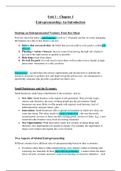Unit 1 – Chapter 1
Entrepreneurship: An Introduction
Starting an Entrepreneurial Venture: Four Key Ideas
Four key ideas that make a small business (involves 1-50 people and has its owner managing
the business on a day-to-day basis) a success:
1. Believe that you can do this: the belief that you can achieve your goals is called self-
efficacy.
2. Planning + Action = Success: Success comes from having the right sort of plan to
get you to the right actions as quickly as possible.
3. Help helps: learn from others.
4. Do well. Do good: You will need to treat others well in order to have friends in high
places later. Sometimes it’s who you know.
Entrepreneur – an individual who notices opportunities and decides how to mobilise the
resources necessary to produce new and improved goods and services. An entrepreneur is
specifically someone who provides a good/service that is new.
Small Businesses and the Economy
Small businesses make large contributions to the economy, such as:
• New Jobs: Small business is the engine of job generation. They provide wages,
salaries and, therefore, the taxes working people pay the government. Small
businesses are more likely to offer people with atypical work histories, lack of
skills/education, and part-timers, jobs.
• Innovations: Small businesses offer a special environment in which new ideas can
come into being. This often results in creative destruction – the way that newly
created goods, services or firms can hurt existing goods, services or firms. E.g., a new
restaurant takes business away from an existing restaurant.
• New Opportunities: With innovation comes new avenues of doing things and,
therefore, new opportunities for people to explore. For example, the opportunity to
target a new market and expand into a new location.
Two Aspects of Global Entrepreneurship
Different countries have different rates of entrepreneurship based on their economies;
• In nations where there is little manufacturing, most industry relates to farming and
extracting raw materials. In these factor-driven economies – a nation where the major
forces for jobs, revenues and taxes come from farming or extractive industries – such
, as Pakistan, Jamaica and Venezuela, entrepreneurship is essential to helping build
personal wealth and breaking the cycle of low-wage jobs, and entrepreneurship levels
are very high.
• In more industrialised economies (Russia, Brazil and China) it is called an efficiency-
driven economy – a nation where industrialisation is becoming the major force
proving jobs, revenue and taxes and where minimising costs while maximising
productivity is a major goal. In these economies entrepreneurship becomes a key way
to build the middle class, and a growing retail and wholesale sector grows alongside
businesses serving the needs of large industrial concerns. Entrepreneurship levels are
middle range.
• Innovation-driven economies – a nation where the major forces for jobs, revenues and
taxes come form high-level-added production bases on new ideas and tech and from
professional services based on higher education – are marked by a very large service
sector providing high-end services locally and abroad. Examples of these countries –
Germany, South Korea, the USA. This is the lowest rate of entrepreneurship from the
3 economies.
The two different types of entrepreneurship follow the types of economies;
• Opportunity-driven entrepreneurship is about creating a firm to improve themselves
financially, or to launch a new product or service into the market. These types of
entrepreneurs are more often found in innovation-driven economies.
• Necessity-driven entrepreneurship are more often found in factor-driven economies
because these types of entrepreneurs don’t see any prospect of being employed by
someone else and, therefore, become entrepreneurs out of necessity.
Beyond Small business: CSI Entrepreneurship
CSI entrepreneurship – an acronym for the three forms of entrepreneurship (the setting in
which the entrepreneurial effort takes place.)
• Corporate entrepreneurs: entrepreneurs employed by others in existing companies
focusing on new products and services. Large focus on customer, efficiency and
innovation
• Social entrepreneurs: involving the creation of self-sustaining charitable and civic
organisations, or for-profit organisations that invest significant profits in charitable
activities. Focus on creation, customer and efficiency. Often described as sustainable
or green entrepreneurship.
• Independent entrepreneurs: people who start a business on their own. Focus on
creation, customer, efficiency and innovation.
The three forms differ in which aspect of entrepreneurship they focus on, these are the key
directions organisations intend to pursue:
• Creation: the making of new entities.
• Customer-focus: being in-tune to one’s market.
• Efficiency: doing the most work with the fewest resources.




